 W
WA baton is a roughly cylindrical club made of wood, rubber, plastic, or metal. It is carried as a compliance tool and defensive weapon by law-enforcement officers, correctional staff, security guards and military personnel.
 W
WThe bulava or buława is a ceremonial mace or baton.
 W
WA bulibuli or vunikau bulibuli is a fijian war club.
 W
WA Culacula is a paddle war club from Fiji.
 W
WThe gada is a mallet or blunt mace from the Indian subcontinent. Made either of wood or metal, it consists essentially of a spherical head mounted on a shaft, with a spike on the top. Outside India, the gada was also adopted in Southeast Asia, where it is still used in silat.
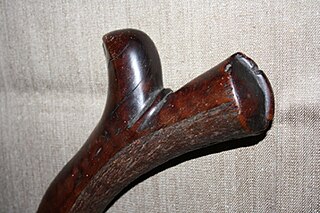 W
WThe Gata or Gata waka is a war club from Fiji.
 W
WThe gunstock club or gun stock war club is an indigenous weapon used by Native Americans, named for its similar appearance to the wooden stocks of muskets and rifles of the time. Gunstock clubs were most predominantly used by Eastern Woodland, Central and Northern Plains tribes in the 18th and 19th centuries.
 W
WA hakapik is a club, of Norwegian design, used for killing seals. The hakapik is a multipurpose hunting tool—a heavy wooden club, with a hammer head, and a hook on the end.
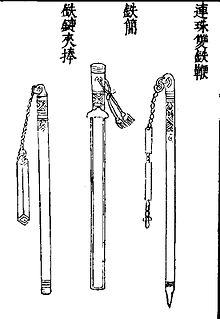 W
WThe Jiǎn or Tie Jian, also known as Chinese swordbreaker, is a type of quad-edged straight mace or club specifically designed to break weapons with sharp edges. The traditional Chinese weapon has a rectangular cross section with sharp corners, making it ideal to focus on damaging other weapons with brutal impact. It also ends with a tip.
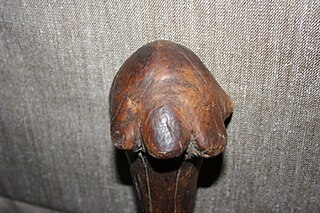 W
WA Kanak war club is a traditional weapon (mace) of the Kanak tribes of New Caledonia.
 W
WKaumodaki is the gadā (mace) of the Hindu god Vishnu. Vishnu is often depicted holding the Kaumodaki in one of his four hands; the other attributes are the chakra, the conch and the lotus. The gada is also found in the iconography of some of Vishnu's avatars.
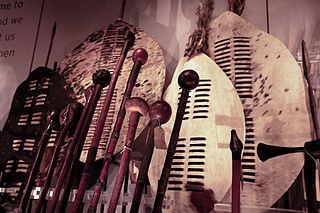 W
WA knobkerrie, also spelled knobkerry, knobkierie, and knopkierie (Afrikaans), is a form of club used mainly in Southern and Eastern Africa. Typically they have a large knob at one end and can be used for throwing at animals in hunting or for clubbing an enemy's head.
 W
WKotiate is a type of traditional hand weapon of the Māori, the indigenous people of New Zealand.
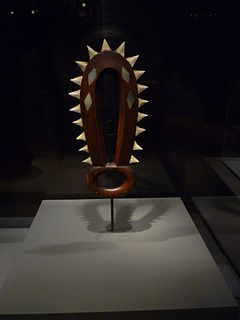 W
WThe leiomano is a shark-toothed club used by various Polynesian cultures, but mostly by the native Hawaiians.
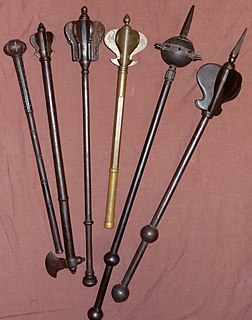 W
WA mace is a blunt weapon, a type of club or virge that uses a heavy head on the end of a handle to deliver powerful strikes. A mace typically consists of a strong, heavy, wooden or metal shaft, often reinforced with metal, featuring a head made of stone, bone, copper, bronze, iron, or steel.
 W
WThe mere is a type of short, broad-bladed weapon in the shape of an enlarged tear drop. It was used to strike/jab an opponent in the body or the head, usually made from nephrite jade. A mere is one of the traditional, hand to hand, one-handed weapons of the indigenous Māori of New Zealand, and a symbol of chieftainship.
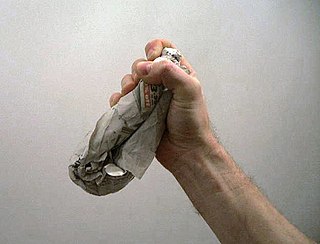 W
WA "Millwall brick" is an improvised weapon made of a manipulated newspaper, used as a small club. It was named after supporters of Millwall F.C., who had a reputation for football hooliganism. The Millwall brick was allegedly used as a stealth weapon at football matches in England during the 1960s and 1970s. The weapon's popularity appears to have been due to the wide availability of newspapers, the difficulty in restricting newspapers being brought into football grounds, and the ease of its construction.
 W
WA morning star is the metal-spiked, ball-shaped or rounded-shaped end piece of a club or flail. It also refers to the weapon as a whole. Wielding a morning star combines blunt-force and puncture attacks in one.
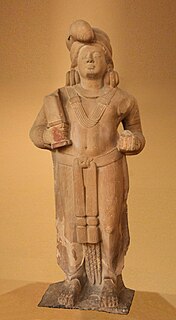 W
WA Mudgar is a type of "Gada" mace from India, and it is generally considered to be made of wood, but can also be made of iron.
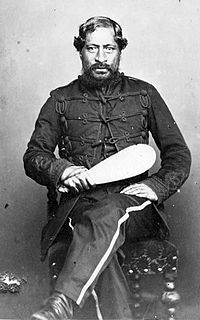 W
WA patu is a club or pounder used by the Māori. The word patu in the Māori language means to strike, hit, beat, kill or subdue.
 W
WA pernach is a type of flanged mace originating in the 12th century in the region of Kievan Rus' and later widely used throughout Europe. The name comes from the Slavic word перо (pero) meaning feather, referring to a type of pernach resembling an arrow with feathering.
 W
WA qauata or qauaata is a parrying shield or war club of the San Cristobal Island in the Solomon Islands.
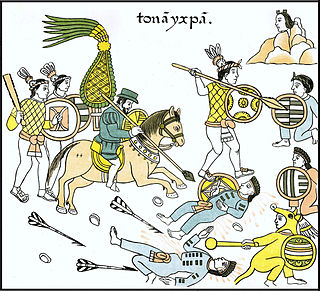 W
WThe Quauholōlli was a blunt weapon used by Mesoamerican peoples. It consisted of a wooden stick ending in a hard ball, ideal for breaking bones. This weapon is represented in the Lienzo de Tlaxcala, Codex Duran and the Florentine codex.
 W
WA Sali or Cali or Tebetebe is a war club from Fiji.
 W
WSharur(Sumerian:𒊹𒃡 šar₂-ur₃), which means "smasher of thousands" is the weapon and symbol of the god Ninurta. Sumerian mythic sources describe it as an enchanted talking mace. It has been suggested as a possible precursor for similar objects in other mythology such as Arthurian lore.
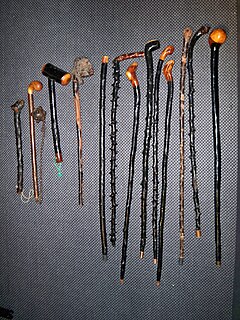 W
WA shillelagh is a wooden walking stick and club or cudgel, typically made from a stout knotty blackthorn stick with a large knob at the top. It is associated with Ireland and Irish folklore.
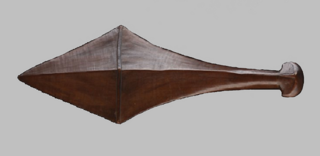 W
WThe supi is a war club of the Solomon Islands.
 W
WA tewhatewha is a long-handled Māori club weapon shaped like an axe. Designed to be held in two hands, the weapon comes to a mata (point) at one end and a rapa at the other.
 W
WThe totokia is a type of club or battlehammer from Fiji.
 W
WTrench raiding clubs were homemade melee weapons used by both the Allies and the Central Powers during World War I. Clubs were used during nighttime trench raiding expeditions as a quiet and effective way of killing or wounding enemy soldiers. The clubs were usually made out of wood. It was common practice to fix a metal object at the striking end in order to maximize the injury inflicted. Another common design comprised a simple stave with the end drilled out and a lead weight inserted, with rows of large hobnails hammered in around its circumference. Most designs had some form of cord or leather strap at the end to wrap around the user's wrist. Bosnian soldiers serving in the Austro-Hungarian army were fond of using maces. They were also used by officers to finish enemy soldiers wounded by poison gas attacks.
 W
WThe U'u is a war club of the Marquesas Islands.
 W
WA waddy, nulla-nulla or boondi is an Aboriginal Australian hardwood club or hunting stick for use as a weapon or as a throwing stick for hunting animals. The first of these names comes from the Darug people of Port Jackson, Sydney. Boondi is the Wiradjuri word for this implement.
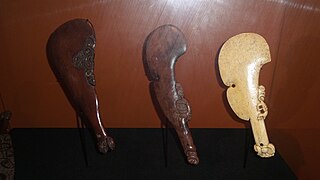 W
WA Wahaika is a type of traditional Māori hand weapon. Wahaika are short club-like weapons usually made of wood or whalebone and are used for thrusting and striking in close-quarter, hand-to-hand fighting. Whalebone wahaika are called wahaika parāoa.